Thanksgiving
Thanksgiving Day is a national holiday celebrated on various dates in the United States, Canada, some of the Caribbean islands, and Liberia. It began as a day of giving thanks and sacrifice for the blessing of the harvest and of the preceding year. Similarly named festival holidays occur in Germany and Japan. Thanksgiving is celebrated on the second Monday of October in Canada and on the fourth Thursday of November in the United States and Brazil, and around the same part of the year in other places. Although Thanksgiving has historical roots in religious and cultural traditions, it has long been celebrated as a secular holiday as well.
| Thanksgiving Day | |
|---|---|
_Thanksgiving_Dinner.jpg) A North American Thanksgiving dinner | |
| Observed by | Countries
Sub-national entities |
| Type | National, cultural |
| Date | 2nd Monday in October (Canada) 1st Thursday in November (Liberia) Last Wednesday in November (Norfolk Island) 4th Thursday in November (U.S. and Brazil) |
| 2020 date | October 12, 2020 (Canada); November 5, 2020 (Liberia); |
| 2021 date | October 11, 2021 (Canada); November 4, 2021 (Liberia); |
History
Prayers of thanks and special thanksgiving ceremonies are common among almost all religions after harvests and at other times.[1] The Thanksgiving holiday's history in North America is rooted in English traditions dating from the Protestant Reformation. It also has aspects of a harvest festival, even though the harvest in New England occurs well before the late-November date on which the modern Thanksgiving holiday is celebrated.[1][2]
In the English tradition, days of thanksgiving and special thanksgiving religious services became important during the English Reformation in the reign of Henry VIII and in reaction to the large number of religious holidays on the Catholic calendar. Before 1536 there were 95 Church holidays, plus 52 Sundays, when people were required to attend church and forego work and sometimes pay for expensive celebrations. The 1536 reforms reduced the number of Church holidays to 27, but some Puritans wished to completely eliminate all Church holidays, including Christmas and Easter. The holidays were to be replaced by specially called Days of Fasting or Days of Thanksgiving, in response to events that the Puritans viewed as acts of special providence. Unexpected disasters or threats of judgement from on high called for Days of Fasting. Special blessings, viewed as coming from God, called for Days of Thanksgiving. For example, Days of Fasting were called on account of drought in 1611, floods in 1613, and plagues in 1604 and 1622. Days of Thanksgiving were called following the victory over the Spanish Armada in 1588 and following the deliverance of Queen Anne in 1705.[3] An unusual annual Day of Thanksgiving began in 1606 following the failure of the Gunpowder Plot in 1605 and developed into Guy Fawkes Day on November 5.[3]
In Canada
According to some historians, the first celebration of Thanksgiving in North America occurred during the 1578 voyage of Martin Frobisher from England in search of the Northwest Passage.[4] Other researchers, however, state that "there is no compelling narrative of the origins of the Canadian Thanksgiving day."[5]
The origins of Canadian Thanksgiving are also sometimes traced to the French settlers who came to New France in the 17th century, who celebrated their successful harvests. The French settlers in the area typically had feasts at the end of the harvest season and continued throughout the winter season, even sharing food with the indigenous peoples of the area.[6]
As settlers arrived in Nova Scotia from New England after 1700, late autumn Thanksgiving celebrations became commonplace. New immigrants into the country—such as the Irish, Scottish, and Germans—also added their own traditions to the harvest celebrations. Most of the US aspects of Thanksgiving (such as the turkey) were incorporated when United Empire Loyalists began to flee from the United States during the American Revolution and settled in Canada.[6]
In the United States

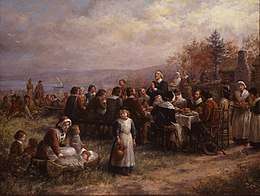
Pilgrims and Puritans who emigrated from England in the 1620s and 1630s carried the tradition of Days of Fasting and Days of Thanksgiving with them to New England. The modern Thanksgiving holiday tradition is traced to a well-recorded 1619 event in Virginia and a sparsely documented 1621 celebration at Plymouth in present-day Massachusetts. The 1619 arrival of 38 English settlers at Berkeley Hundred in Charles City County, Virginia, concluded with a religious celebration as dictated by the group's charter from the London Company, which specifically required "that the day of our ships arrival at the place assigned ... in the land of Virginia shall be yearly and perpetually kept holy as a day of thanksgiving to Almighty God." The 1621 Plymouth feast and thanksgiving was prompted by a good harvest, which the Pilgrims celebrated with Native Americans, who helped them get through the previous winter by giving them food in that time of scarcity.[7][8][9]
Several days of Thanksgiving were held in early New England history that have been identified as the "First Thanksgiving", including Pilgrim holidays in Plymouth in 1621 and 1623, and a Puritan holiday in Boston in 1631.[10][11] According to historian Jeremy Bangs, director of the Leiden American Pilgrim Museum, the Pilgrims may have been influenced by watching the annual services of Thanksgiving for the relief of the siege of Leiden in 1574, while they were staying in Leiden.[12] Now called Oktober Feest, Leiden's autumn thanksgiving celebration in 1617 was the occasion for sectarian disturbance that appears to have accelerated the pilgrims' plans to emigrate to America.[13] Later in Massachusetts, religious thanksgiving services were declared by civil leaders such as Governor Bradford, who planned the colony's thanksgiving celebration and fast in 1623.[14][15][16] The practice of holding an annual harvest festival did not become a regular affair in New England until the late 1660s.[17]
Thanksgiving proclamations were made mostly by church leaders in New England up until 1682, and then by both state and church leaders until after the American Revolution. During the revolutionary period, political influences affected the issuance of Thanksgiving proclamations. Various proclamations were made by royal governors, John Hancock, General George Washington, and the Continental Congress,[18] each giving thanks to God for events favorable to their causes.[19] As President of the United States, George Washington proclaimed the first nationwide thanksgiving celebration in America marking November 26, 1789, "as a day of public thanksgiving and prayer, to be observed by acknowledging with grateful hearts the many and signal favours of Almighty God".[20]
Debate about the nation's first celebrations
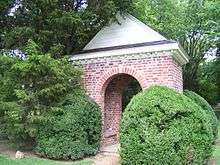
The question of where the first Thanksgiving was held in the United States has been a subject of debate, primarily between New England and Virginia, complicated by the concept of Thanksgiving as a holiday celebration versus a religious service. James Baker maintains, "The American holiday's true origin was the New England Calvinist Thanksgiving. Never coupled with a Sabbath meeting, the Puritan observances were special days set aside during the week for thanksgiving and praise in response to God's providence."[10] Baker calls the debate a "tempest in a beanpot" and "marvelous nonsense" based on regional claims.[10] However, the day for Thanksgiving services specifically codified in the founding charter of Berkeley Hundred in 1619 was instrumental in President John F. Kennedy's attempt to strike a compromise between the regional claims, by issuing Proclamation 3560 on November 5, 1963, stating, "Over three centuries ago, our forefathers in Virginia and in Massachusetts, far from home in a lonely wilderness, set aside a time of thanksgiving. On the appointed day, they gave reverent thanks for their safety, for the health of their children, for the fertility of their fields, for the love which bound them together, and for the faith which united them with their God."[21]
Other claims include an earlier religious service by Spanish explorers in Texas at San Elizario in 1598.[22] Robyn Gioia and Michael Gannon of the University of Florida argue that the earliest Thanksgiving service in what is now the United States was celebrated by the Spanish on September 8, 1565, in current Saint Augustine, Florida.[23][24]
Fixing date
Canada
The earlier Thanksgiving celebrations in Canada has been attributed to the earlier onset of winter in the North, thus ending the harvest season earlier.[25] Thanksgiving in Canada did not have a fixed date until the late 19th century. Prior to Canadian Confederation, many of the individual colonial governors of the Canadian provinces had declared their own days of Thanksgiving. The first official Canadian Thanksgiving occurred on April 15, 1872, when the nation was celebrating the Prince of Wales' recovery from a serious illness.[25] By the end of the 19th century, Thanksgiving Day was normally celebrated on November 6. In the late 1800s, the Militia staged "sham battles" for public entertainment on Thanksgiving Day. The Militia militated for an earlier date for the holiday so they could use the warmer weather to draw bigger crowds.[26] However, when World War I ended, the Armistice Day holiday was usually held during the same week. To prevent the two holidays from clashing with one another, in 1957 the Canadian Parliament proclaimed Thanksgiving to be observed on its present date on the second Monday of October.[6]
United States
Thanksgiving in the United States has been observed on differing dates. From the time of the Founding Fathers until the time of Lincoln, the date of observance varied from state to state. The final Thursday in November had become the customary date in most U.S. states by the beginning of the 19th century, coinciding with, and eventually superseding the holiday of Evacuation Day (commemorating the day the British exited the United States after the Revolutionary War).[27] Modern Thanksgiving was proclaimed for all states in 1863 by Abraham Lincoln. Influenced by Sarah Josepha Hale, who wrote letters to politicians for approximately 40 years advocating an official holiday, Lincoln set national Thanksgiving by proclamation for the final Thursday in November, explicitly in celebration of the bounties that had continued to fall on the Union and for the military successes in the war.[28] Because of the ongoing Civil War, a nationwide Thanksgiving celebration was not realized until Reconstruction was completed in the 1870s.
On October 31, 1939, President Franklin D. Roosevelt signed a presidential proclamation changing the holiday to the next to last Thursday in November, for business reasons.[29] On December 26, 1941, he signed a joint resolution of Congress changing the national Thanksgiving Day to the fourth Thursday in November.[30]
Since 1971, when the American Uniform Monday Holiday Act took effect, the American observance of Columbus Day has coincided with the Canadian observance of Thanksgiving.[31][32]
Observance
Australia
In the Australian external territory of Norfolk Island, Thanksgiving is celebrated on the last Wednesday of November, similar to the pre–World War II American observance on the last Thursday of the month. This means the Norfolk Island observance is the day before or six days after the United States' observance. The holiday was brought to the island by visiting American whaling ships.[33]
Brazil
In Brazil, National Thanksgiving Day was instituted by President Gaspar Dutra, through Law 781 of August 17, 1949, at the suggestion of Ambassador Joaquim Nabuco, who was enthusiastic about the commemorations he saw in 1909 in St. Patrick's Cathedral as an ambassador in Washington. In 1966, Law 5110 established that the Thanksgiving celebration would take place on the fourth Thursday of November.[34] This date is celebrated by many families of American origin, by some Protestant Christian denominations, such as the Evangelical Lutheran Church of Brazil (which is of American origin), the Presbyterian Church, the Baptist Church, the Methodist Church, and the Church of the Nazarene, and Methodist denominational universities. The day is also celebrated by evangelical churches such as the Foursquare Gospel Church in Brazil.
Canada
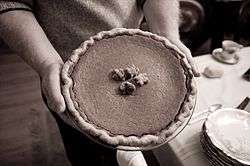
Thanksgiving (French: l'Action de grâce), occurring on the second Monday in October, is an annual Canadian holiday to give thanks at the close of the harvest season. Although the original act of Parliament references God and the holiday is celebrated in churches, the holiday is mostly celebrated in a secular manner. Thanksgiving is a statutory holiday in all provinces in Canada, except for New Brunswick and Nova Scotia. While businesses may remain open in these provinces, the holiday is nonetheless recognized and celebrated regardless of its status.[35][36][37][38][39]
Grenada
In the West Indian island of Grenada, in the Caribbean, there is a national holiday known as Thanksgiving Day which is celebrated on October 25. Even though it bears the same name, and is celebrated at roughly the same time as the American and Canadian versions of Thanksgiving, this holiday is unrelated to either of those celebrations. Instead the holiday marks the anniversary of the U.S.-led invasion of the island in 1983, in response to the deposition and execution of the socialist Grenadian Prime Minister Maurice Bishop[40] by a military government from within his own party.
Liberia
In the West African country of Liberia, Thanksgiving is celebrated on the first Thursday of November.[41] The Thanksgiving tradition there is rooted in the nation's founding as a colony of the American Colonization Society in 1821 by free people of color from the United States. Although recognized throughout the country, Thanksgiving is practiced chiefly by Americo-Liberians, descendants of Liberia's original African-American settlers.
Netherlands
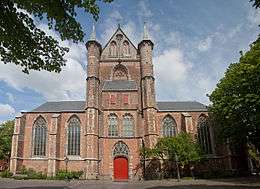
Many of the Pilgrims who migrated to the Plymouth Plantation resided in the city of Leiden from 1609–1620, and had recorded their births, marriages, and deaths at the Pieterskerk (St. Peter's church). In commemoration, a non-denominational Thanksgiving Day service is held each year on the morning of the American Thanksgiving Day in the Pieterskerk, a Gothic church in Leiden, noting the hospitality the Pilgrims received in Leiden on their way to the New World.[42]
Thanksgiving is observed by orthodox Protestant churches in The Netherlands on the first Wednesday in November (Dankdag). It is not a public holiday. Those who observe the day either go to church in the evening or take the day off and go to church in the morning (and occasionally afternoon) too.
Philippines
The Philippines, while it was an American colony in the first half of the 20th century, celebrated Thanksgiving as a special public holiday on the same day as the Americans. During the Japanese occupation during World War II, both the Americans and Filipinos celebrated Thanksgiving in secret. After Japanese withdrawal in 1945, the tradition continued until 1969. It was revived by President Ferdinand Marcos, but the date was changed to be on every September 21, when martial law was imposed in the country. After Marcos' ouster in 1986, the tradition was no longer continued, due to the controversial events that occurred during his long administration.[43]
Today Thanksgiving Day is now recently being celebrated as a commercial and cultural holiday, albeit stripped of its official status. SM Supermalls led the way in the slow revival of Thanksgiving Day on the same day as in the US, as in the old days. Many malls and hotels offer special sales on this day, which is part of the long celebration of Christmas in the Philippines, which begins in September (unlike on Black Friday in the United States).
Saint Lucia
The nation of Saint Lucia celebrates Thanksgiving on the first Monday in October.[44]
United States
Thanksgiving, celebrated on the fourth Thursday in November since 1941 due to federal legislation, has been an annual tradition in the United States by presidential proclamation since 1863 and by state legislation since the Founding Fathers of the United States. Traditionally, Thanksgiving has been a celebration of the blessings of the year, including the harvest.[45] What Americans call the "Holiday Season" generally begins with Thanksgiving.[46] Thanksgiving is celebrated both with family and in public places with parades such as Macy's Thanksgiving Parade[47] in New York City, ABC Dunkin' Donuts Thanksgiving Day Parade[48] in Philadelphia, America's Hometown Thanksgiving Parade in Plymouth, Massachusetts, McDonald's Thanksgiving Parade in Chicago, and Bayou Classic Thanksgiving Parade[49] in New Orleans. The first day after Thanksgiving Day—Black Friday—marks the start of the Christmas shopping season.[50]
Similar holidays
Germany

The Harvest Thanksgiving Festival, Erntedankfest, is a popular German Christian festival on the first Sunday of October. The festival has a significant religious component, and unlike its North American counterpart, it usually does not include large dinners. Many churches are decorated with autumn crops, beautifully arranged in front of the altar. In some places, there are religious processions or parades. Many Bavarian beer festivals, like the Munich Oktoberfest, take place within the vicinity of Erntedankfest.
The United States has observed German-American Day annually on October 6, within the vicinity of Erntedankfest, from 1883 until the early 1910s, then again from 1983 to the present day.
Japan
Labor Thanksgiving Day (勤労感謝の日, Kinrō Kansha no Hi) is a national holiday in Japan. It takes place annually on November 23. The law establishing the holiday, which was adopted during the American occupation after World War II, cites it as an occasion for commemorating labor and production and giving one another thanks. It has roots in the ancient Shinto harvest ceremony (Niiname-sai (新嘗祭)).
United Kingdom
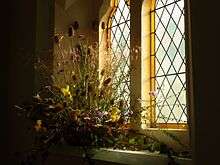
The Harvest Festival of Thanksgiving does not have an official date in the United Kingdom; however, it is traditionally held on or near the Sunday of the harvest moon that occurs closest to the autumnal equinox. Harvest Thanksgiving in Britain also has pre-Christian roots when the Saxons would offer the first sheaf of barley, oats, or wheat to fertility gods. When the harvest was finally collected, communities would come together for a harvest supper.[51] When Christianity arrived in Britain many traditions remained, and today the Harvest Festival is marked by churches and schools in late September/early October (same as Canada) with singing, praying and decorating with baskets of food and fruit to celebrate a successful harvest and to give thanks.[52] Collections of food are usually held which are then given to local charities which help the homeless and those in need.
India
Pongal is celebrated in countries such as India, Sri Lanka,[53][54] and Malaysia.[55] In other parts of India, similar harvest festivals are celebrated as Makar Sankranti and Monti Fest. It is a four-day festival, which according to the Gregorian calendar is normally celebrated from January 14 to January 16.[56] This corresponds to the period from the last day of the Tamil month Maargazhi to the third day of the Tamil month Thai and in the end of the Kannada month Dannur which is usually on 14th day of January. The festival is mainly celebrated to convey appreciation to the Sun God for a successful harvest. Part of the celebration is the boiling of the first rice of the season consecrated to the Sun – the Surya Maangalyam. The origins of the Thai Pongal festival may date back more than 1000 years.
In Western Odisha, the day of Pousa Purnima on the saka calendar is commonly known as Pus Puni. It is marked as a day of thanksgiving to mother nature for a good harvest and is celebrated by making regional food items cultivated and harvested by farmers, all food items are given out and served as a reminder of being caretakers of the harvest.
See also
Citations
- Hodgson, pp. 156–59
- Baker, Chapter 1, especially pp. 12–15.
- Baker, James W. (2009). Thanksgiving: the biography of an American holiday. UPNE. pp. 1–14. ISBN 9781584658016.
- Mills, David; Neilson Bonikowsky, Laura; McIntosh, Andrew. "Thanksgiving in Canada". Canadian Encyclopedia. Historica Canada. Retrieved October 6, 2017.
- Kaufman, Jason Andrew (2009). The Origins of Canadian & American Political Differences. Harvard University Press. p. 29. ISBN 978-0674031364.
- Solski, Ruth "Canada's Traditions and Celebrations" McGill-Queen's Press,ISBN 1550356941 p. 12
- "The First Thanksgiving". The Virginia Historical Society. Retrieved November 29, 2016.
- Dowdy, Clifford (1957). The Great Plantation. Rinehart and Co. pp. 29–37.
- Globe, Sheryl Julian, The Boston. "HISTORY IS SERVED". chicagotribune.com.
- Baker, Chapter 1.
- Alvin J. Schmidt (2004). How Christianity Changed the World. Zondervan. ISBN 9780310264491. Retrieved January 30, 2012.
Their leader, Governor William Bradford, issued a formal proclamation commanding the people to give thanks to God for having received divine protection during a terrible winter and for having received their first harvest. It was also new that the Pilgrims celebrated their thanksgiving by eating wild turkey (an indigenous bird) and venison.
- Jeremy Bangs. "Influences". The Pilgrims' Leiden. Archived from the original on January 13, 2012. Retrieved September 11, 2010.
- Bunker, Nick (2010). Making Haste From Babylon: the Mayflower Pilgrims and Their World. New York: Vintage Books. pp. 220–21. ISBN 9780307386267.
- Bradford, Of Plymouth Plantation, 1620–1647, pp. 120–21.
- Bradford, History of Plymouth Plantation, pp. 135–42.
- The fast and thanksgiving days of New England by William DeLoss Love, Houghton, Mifflin and Co., Cambridge, 1895
- Kaufman, Jason Andrew (2009). The origins of Canadian and American political differences. Cambridge, MA: Harvard University Press. p. 28. ISBN 978-0674031364.
- Klos, Stanley. "Thanksgiving Day Proclamations". Presidential Thanksgiving Proclamations. Historic.us. Retrieved October 16, 2013.
- Hodgson, pp. 159–66
- Hodgson, p. 167
- "John F. Kennedy 35th President, Thanksgiving Proclamation, Nov. 5, 1963". The American Presidency Project. Retrieved November 24, 2016.
- C. Michael Hogan (2011). Thanksgiving. Eds. Cutler Cleveland & Peter Saundry. Encyclopedia of Earth. National Council for Science and the Environment. Washington DC
- Wilson, Craig (November 21, 2007). "Florida teacher chips away at Plymouth Rock Thanksgiving myth". Usatoday.com. Retrieved September 5, 2011.
- Davis, Kenneth C. (November 25, 2008). "A French Connection". Nytimes.com. Retrieved September 5, 2011.
- Kaufman, Jason Andrew (2009). "The origins of Canadian and American political differences" Harvard University Press, ISBN 0674031369 p. 29
- Wood, James "Militia Mythes: Ideas of the Canadian Citizen Soldier, 1896-1921." UBC Press, 2010 ISBN 978-0-7748-1765-3 p.30
- "Evacuation Day: New York's Former November Holiday". November 24, 2014. Retrieved April 5, 2019.
- "Thanksgiving Proclamation by Abraham Lincoln". www.abrahamlincolnonline.org. Retrieved October 30, 2018.
- "31 Oct 1939, Page 1 - Green Bay Press-Gazette at Newspapers.com". Newspapers.com.
- "Congress Establishes Thanksgiving". National Archives. August 15, 2016.
- "LBJ Signs Bill to Set Up Five 3-Day Holidays". Sarasota Herald-Tribune. Associated Press. June 29, 1968. Retrieved December 6, 2011.The bill became the Uniform Monday Holiday Act.
- "Text of the 1968 Uniform Monday Holiday Act". US Government Archives (www.archives.gov). Retrieved December 6, 2011.
- "Norfolk Island Information and Services". Archived from the original on September 20, 2010.
- "Dia Nacional de Ações de Graças". Ministério da Justiça e Segurança Pública (in Portuguese). Retrieved November 29, 2019.
- "Archived copy". Archived from the original on December 18, 2010. Retrieved December 8, 2010.CS1 maint: archived copy as title (link)
- "Thanksgiving – is it a Statutory Holiday?". Government of Nova Scotia. Retrieved October 13, 2008.
- "Statutes, Chapter E-6.2" (PDF). Government of Prince Edward Island. Retrieved October 13, 2008.
- "RSNL1990 Chapter L-2 – Labour Standards Act". Assembly of Newfoundland. Retrieved October 13, 2008.
- "Statutory Holidays" (PDF). Ministry of Human Resources and Social Development, Canada. Archived from the original (PDF) on February 29, 2008.
- "Public Holidays & Events 2017". GOV.gd. October 12, 2016. Retrieved April 17, 2017.
- "Vice President Boakai Joins Catholic Community in Bomi to Celebrate Thanksgiving Day". The Executive Mansion. Republic of Liberia. November 5, 2010. Retrieved October 5, 2014.
- "Dutch town". The World (radio program). Retrieved November 28, 2008.
The Pilgrims arrived in Leiden in 1609, after fleeing religious persecution in England. Leiden welcomed them because it needed immigrants to help rebuild its textile industry, which had been devastated by a long revolt against Spain. Here, the Pilgrims were allowed to worship as they wanted, and they even published their arguments calling for the separation of church and state. Jeremy Bangs of the Leiden American Pilgrim Museum says the Pilgrims quickly adopted Dutch customs like civil marriage and Thanksgiving.
- "Thanksgiving in the Philippines". Philippine Presidential Museum and Library. Retrieved November 27, 2015.
- "Saint Lucia's List of Holidays for the Year 2015" (PDF). Stluciachamber.org. Archived from the original (PDF) on March 14, 2016. Retrieved April 17, 2017.
- "Thanksgiving Day". Encyclopædia Britannica. Retrieved November 25, 2011.
- Hargis, Toni (November 4, 2013). "A Brit's Guide to the Holiday Season". BBC America.
- "Macy's Thanksgiving Day Parade". Retrieved April 5, 2019.
- "6ABC THANKSGIVING DAY PARADE". Retrieved April 5, 2019.
- "Bayou Classic". Retrieved April 5, 2019.
- "When is Thanksgiving Day and why is it celebrated". November 22, 2018. Retrieved April 5, 2019.
- "Harvest Festival UK". Crewsnest.vispa.com. Retrieved April 17, 2017.
- "Archived copy". Archived from the original on June 23, 2015. Retrieved June 18, 2015.CS1 maint: archived copy as title (link)
- "Thai Pongal தை பொங்கல் Festival 2015 | University of Sri Jayewardenepura, Sri Lanka". Retrieved July 4, 2015.
- "Washington Embassy celebrates Thai Pongal | Embassy of Sri Lanka – Washington DC". Retrieved July 4, 2015.
- "Malaysian Prime Minister Greets Ethnic Tamils on Pongal". Retrieved July 4, 2015.
- "Pongal – Harvest Festival". pongal-festival.com.
Sources
- Baker, James W. (2009). Thanksgiving: the biography of an American holiday. UPNE. p. 273. ISBN 978-1584658016.
- Bangs, Jeremy D. "Thanksgiving on the Net: Roast Bull with Cranberry Sauce". Sail 1620. Society of Mayflower Descendants in the Commonwealth of Pennsylvania. Archived from the original on November 2, 2012. Retrieved October 23, 2012.
- Colman, Penny (2008). Thanksgiving: The True Story. Macmillan. p. 149. ISBN 978-0805082296.
- Dow, Judy; Slapin, Beverly (June 12, 2006). "Deconstructing the Myths of "The First Thanksgiving"". Oyate.org. Archived from the original on November 29, 2010. Retrieved November 29, 2010.
- Hillstrom, Laurie Collier (2007). The Thanksgiving book: a companion to the holiday covering its history, lore, ... Omnigraphics. p. 328. ISBN 978-0780804036.
- Hodgson, Godfrey (2006). A Great and Godly Adventure; The Pilgrims and the Myth of the First Thanksgiving. New York: Public Affairs. p. 212. ISBN 978-1586483739.
